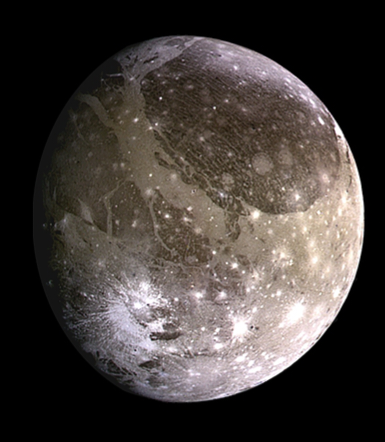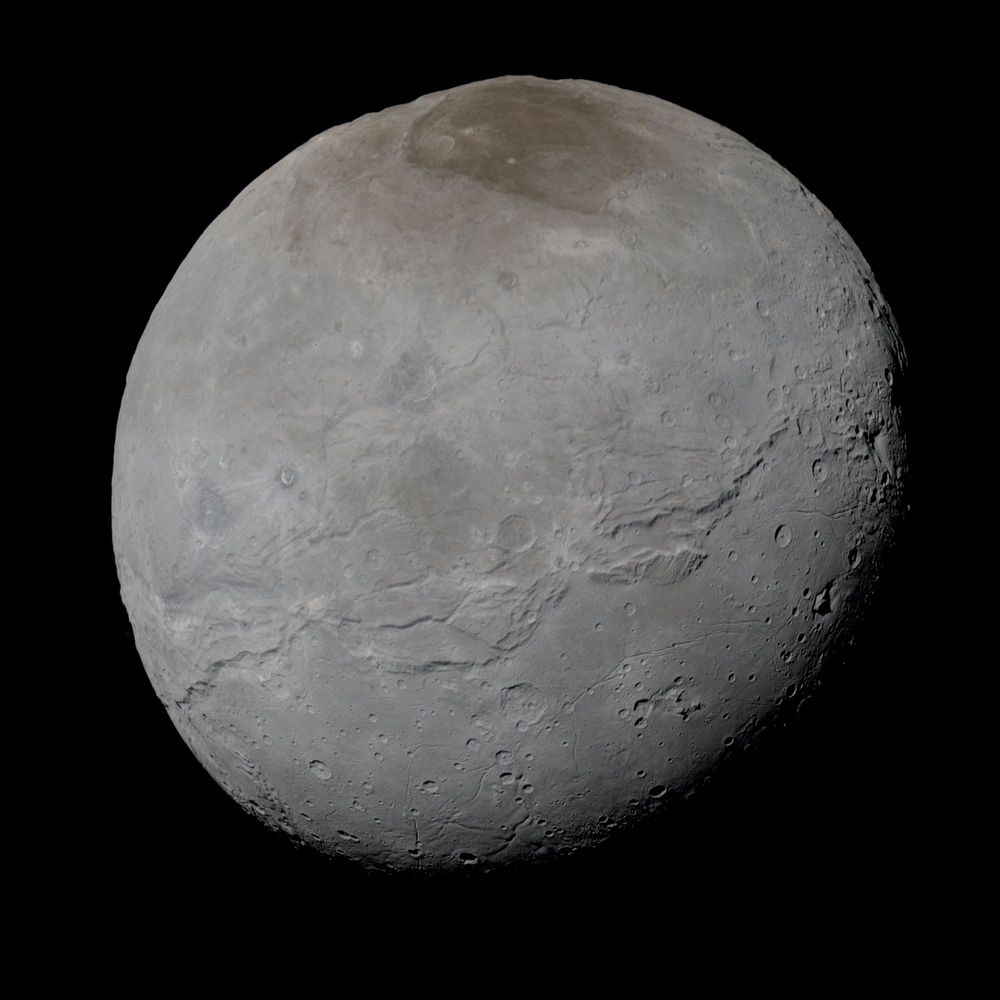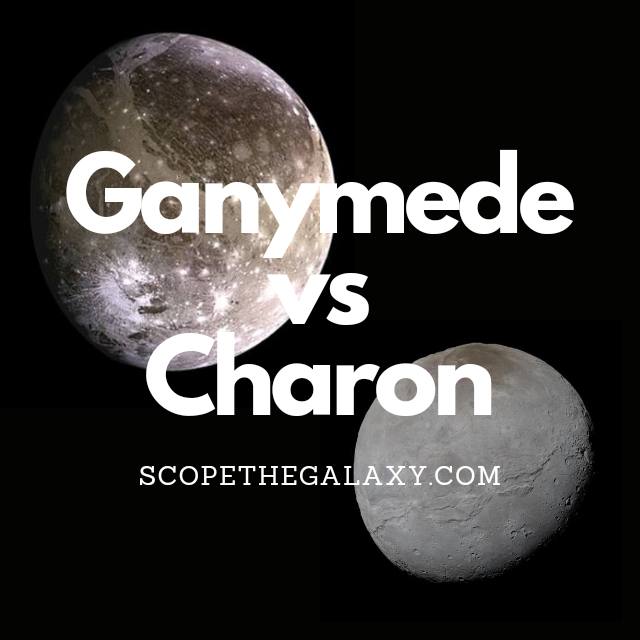*This post may contain affiliate links. This means we may make a commission if you purchase an item using one of our links*
The main differences between Ganymede and Charon is that Ganymede is the largest natural satellite in all of our solar system with a diameter of 5,268km whilst Charon is the 12th largest moon with a diameter of 1,212km, Ganymede orbits Jupiter whilst Charon orbits Pluto and Ganymede has a magnetosphere whilst Charon does not.
There are various other differences between these two so, continue reading if you want a more in depth look at each of these celestial bodies below.
What Is The Moon Ganymede?
Table of Contents

Ganymede is the largest of the Galilean moons – and the largest moon in our entire solar system – first discovered on 7th January 1610. The surface of this icy world is frozen and covered by two main types of landscape: young, light regions and old, crater-filled terrain. And these darker areas seem to contain a number of organic materials.
Using the Hubble Space Telescope, astronomers have found evidence of an oxygen-based atmosphere. Still, it is far too thin to support any living organisms that we know of. Based on this, it’s unlikely that Ganymede hosts life as we know it.
Estimates place Ganymede at around 4.5 billion years old (the same age as its planet, Jupiter), and its average distance from the Sun is approximately 778 million km.
Its diameter is 5,268km, making it larger than the planet Mercury. Despite this, Ganymede only possesses half the mass of Mercury at 1.48 × 10^23kg, so it is still classified as a low-density object.
Ganymede takes seven days to orbit its planet at an average distance of 665,00km, and the temperature varies from minus 112 to minus 193 degrees Celsius. In regards to the moon’s core temperature, that would be around 1,226 – 1,446 degrees Celsius.
Among the fascinating features of this ice moon is its magnetosphere. While many planets possess a magnetosphere, no other moon in our solar system shares this trait.
Measuring the changes in the magnetic fields of Ganymede and Jupiter allowed scientists to predict that salt water lies beneath the surface of this freezing world.
However, this is insufficient to support life when you factor in the other elements of this giant moon. In contrast to Europa, the rocky layer of Ganymede is not directly below the ocean, so life would have a difficult time forming both above and below the ice.
In addition, the thick layer of ice on the moon’s surface would make internal, water-based life challenging for scientists to detect.
What Is The Moon Charon?

Charon is the largest of Pluto’s moons, first discovered on 22nd June 1978. The surface of this icy world is frozen with nitrogen and methane ice; it may also hold some water ice. While Pluto possesses a reddish hue, Charon is closer to a neutral shade of grey; this suggests the two bodies have different compositions.
Scientists named this moon after the mythical ferryman, Charon, who once carried souls across the Acheron river. This river is one of five legendary rivers that could lie beneath the surface of Pluto.
The formation of Charon remains something of a mystery to scientists. However, this moon may have formed around 4.5 billion years ago when an object traveling at immense speed collided with Pluto. Its average distance from the Sun is approximately 3.6 billion km.
Charon is almost half the size of its planet at 1,212km, where scientists refer to these two bodies as a “double dwarf planet system,” and the chilly temperatures vary from minus 23 to minus 258 degrees Celsius.
Charon takes 153 hours to orbit its planet at an average distance of 19,640km, and it is tidally locked, meaning the same side of the moon always faces Pluto. Pluto also experiences a tidal lock to Charon, so the same two sides always face one another.
Among the fascinating features of this ice moon are the ice volcanoes that could exist on the surface. Observations from the Gemini observatory suggest that Charon could have a form of cryovolcanism known as ice-particle geysers.
The frigid world also has a canyon between seven and nine kilometers deep. (To put that into perspective, Mount Everest has a height of 8.8km).
Similarities Between Ganymede And Charon
As both are natural satellites, Charon and Ganymede do share a few similarities, which includes the following:
- Both have a hotter central core.
- Both have a rocky, terrestrial surface.
- Both are spherical in shape.
- Neither have rings surrounding them.
- Both are tidally locked to their planet.
- Both orbit their planet in an elliptical pattern.
- Neither have tectonic plates.
Differences Between Ganymede And Charon
As for the differences between the two, they include the following:
- Ganymede is the bigger of the two with a diameter of 5,268km compared to Charon’s diameter of 1,212km.
- Charon orbits Pluto in an elliptical pattern whilst Ganymede orbits Jupiter elliptically.
- A day on Charon takes 153 hours whilst Ganymede completes a day in 7 days and 3 hours.
- Ganymede orbits the Sun in 12 years and Jupiter in 7 days and 3 hours whilst Charon orbits the Sun in 247.78 years and around Pluto in 153 hours.
- Charon’s density is 1.71 g/cm³ whilst Ganymede’s density is 1.94 g/cm³
- In regards to gravity, Ganymede’s is 1.428 m/s² whilst Charon’s gravity is 0.288 m/s².
- In regards to their axial tilt, the Ganymede’s is 0.3 degrees whilst Charon’s is practically 0 degrees.
- Ganymede has a temperature of -112 to -193 degrees Celsius whilst Charon’s temperature is -23 to -253 degrees Celsius.
- As for mass, Charon’s is 1.58 × 10^21 kg whilst Ganymede’s mass is 1.48 × 10^23kg.
- Charon’s average distance from Pluto is 19,640km whilst Ganymede’s average distance from Jupiter is 1.07 million km.
- Ganymede has a magnetosphere whilst Charon does not.
Summary
As Ganymede and Charon are both natural satellites, they do share a few commonalities such as their low density terrestrial structure, their orbital patterns around the sun and extremely thin atmospheres.
However, they have their differences too, whether it be in regards to mass, size, temperature, having a magnetosphere or not and more, which is why these two aren’t necessarily directly comparable despite both being natural satellites that orbit another planet.

